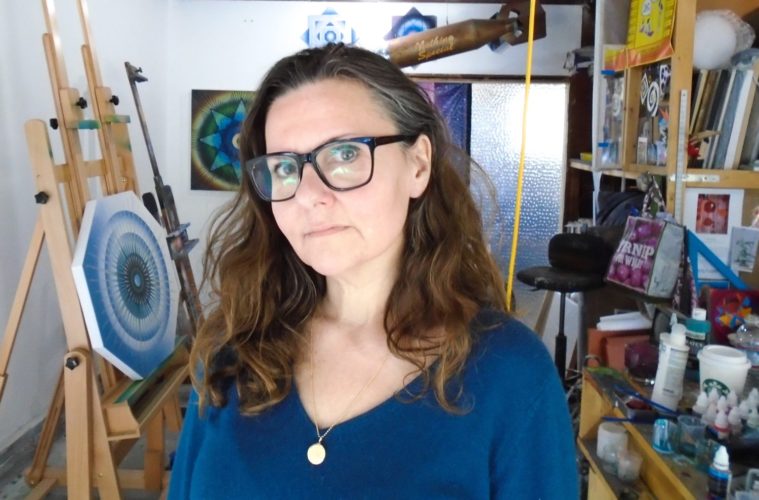Primarily known for her sharp, mandala-like geometric, geodesic abstract paintings, for Mary Anna Pomonis those sparkling gem-toned Op Art delicacies are but the most visually radiant part of her practice. Curatorial and community actions are every bit as central — and all of it is focused on an inclusive, feminist understanding of the world and its energy structures. Her work can currently be seen at LADIES’ ROOM LA in the Bendix Building downtown.
L.A. WEEKLY: When did you first know you were an artist?
MARY ANNA POMONIS: When I was eight years old my mother was diagnosed with breast cancer. She died about twenty months after her diagnosis. One of the last things she said to me was to not waste any time. She told me I had to promise her that I would not settle for anything less than I was capable of. I knew right away she was giving me permission to be an artist. It was a pretty heavy moment, especially since we were a midwest family with small-business roots. She never quite gave herself full creative permission until she was dying. Whether I am successful or not really doesn’t matter to me as much as staying true to that promise. On some level I fear not making work; [the painter] Mark Dutcher and I have talked about that at length. I have a basic fear that inactivity means death.
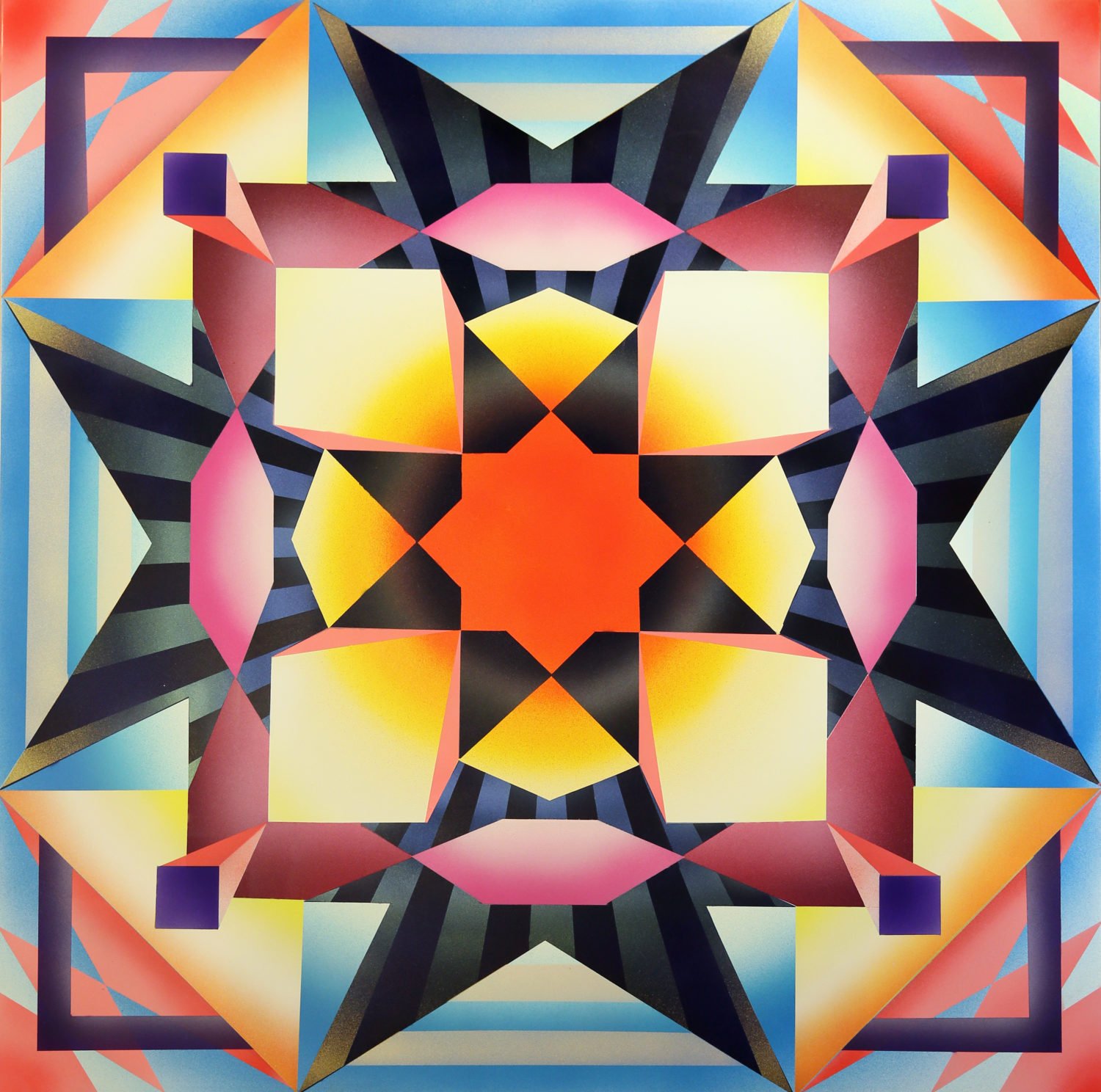
Mary Anna Pomonis, She Is in the Radiant Light,2019,Acrylic on Canvas Over Panel, 36 x 36 inches (Courtesy Ladies Room Los Angeles)
When people ask you what your art is about, what do you say?
I make images that are feminine power symbols using an airbrush. My goal is to create a feeling of divinity, sex, and power in abstract painting. I say that or I say something like, my work is the unholy love child of Judy Chicago and Billy Al Bengston.
What would you be doing if you weren’t an artist?
Ten years ago I would have said a writer. And so I pursued that, writing for art magazines. Five years ago I said, I want to be a professor of Art Education. And so I did that, and am currently on faculty as an Assistant Professor at Cal State Fullerton. Right now I’d say I’d like to be a sign painter or pinstriper. Give me five more years and I’ll tell you how it’s going. I think one of the great things about being an artist is you don’t have to make choices to limit yourself. Everything you research goes into what you make, and everything you make is art. Then you just have to brag about it, and brag about other artists you know and respect.
Sometimes I feel like a professional braggart — like Judy Chicago. No one brags about Judy Chicago more than Judy Chicago. She basically states that if a woman is polite and waits her turn, no one will ever help her. Instead, she advises feminist artists to stop asking permission and to write their own stories and create their own networks of exchange. She is one of the reasons I created the Association of Hysteric Curators with a bunch of other feminist artists. We brag about each other’s work all the time — Allison Stewart, Carolyn Castaño, Diana-Sofia Estrada, Alexis Garcia, Zeal Harris, Eugenia Barbuc, Lili Bernard, Annie Buckley, Christine Dianne Guiyangco, Maya Mackrandilal, Cintia Segovia, Kim Truong, Marjan Vayghan, Anaeis Ohanian, Jessica Vaage, Dajin Yoon and Michiko Yao. I want to name drop here as much as possible because, beyond being a painter, I am a part of the community of artists who I care about deeply. To quote Sabina Ott, “Art is a country; wherever you go, your people are there.”
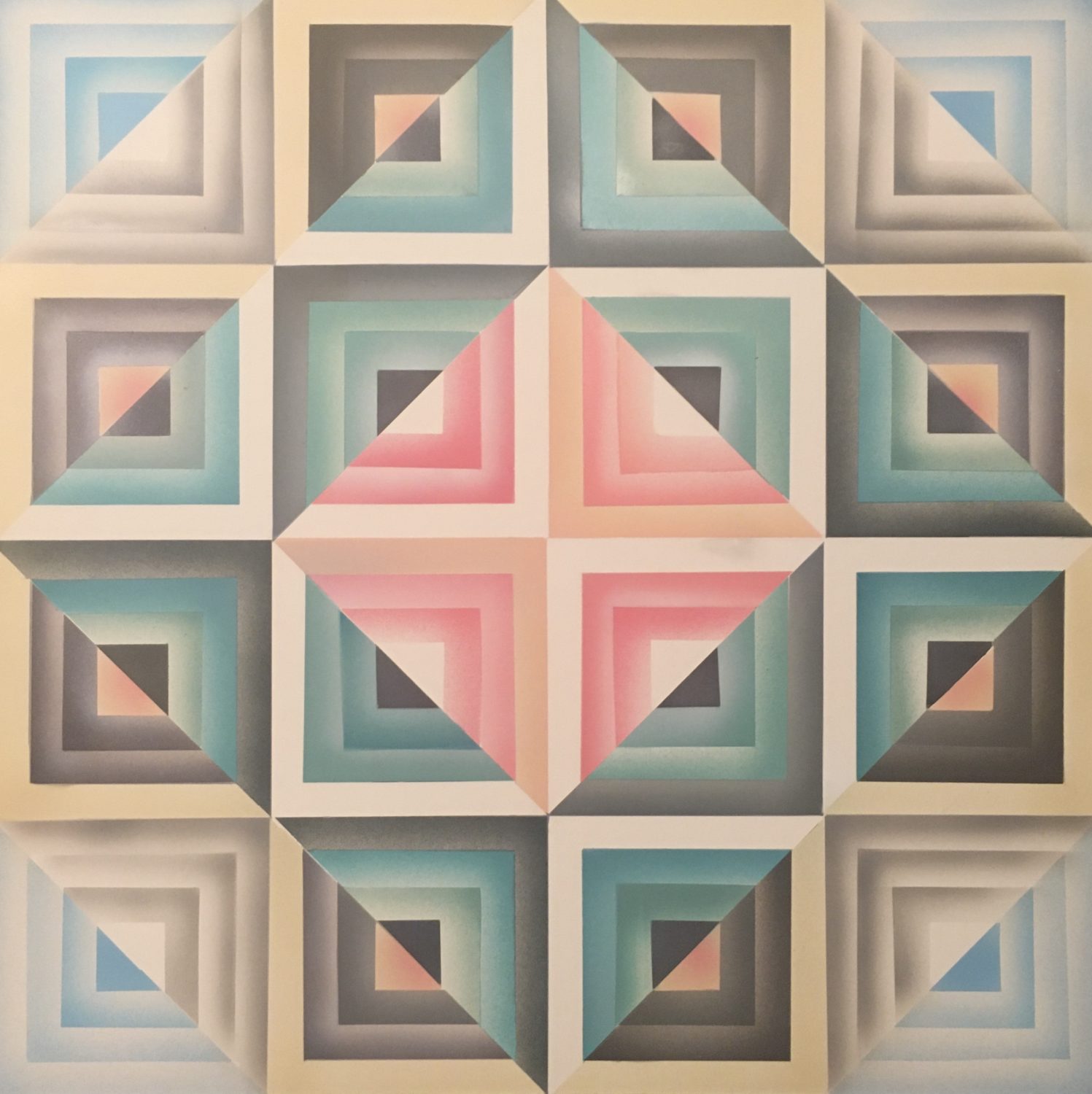
Mary Anna Pomonis, Snake in the Mist, 2019, Acrylic Airbrush On Canvas Over Panel20 x 20 inches (Courtesy Seer Gallery)
Where did you go to school?
I went to the University of Illinois at Urbana Champaign where I studied with Rosalyn Schwartz and Buzz Spector. They both brought Sabina Ott to visit the painting program my senior year. I basically fell in love with Sabina and followed her to Anderson Ranch in Snowmass, Colorado to take a class, then applied to graduate school to study with her.
Why Los Angeles?
My dream was to go to Art Center College of Design or UCLA to work with either Sabina Ott or Lari Pittman. When Sabina moved away from Los Angeles and began teaching at Washington University in St. Louis, I followed her. I learned so much from Sabina in graduate school. She continues to be a huge influence on my work. After I graduated, Sabina instructed me to move to either New York or Los Angeles. For me, there was no contest. New York is cold and I’m Greek; we don’t do well in the cold. Mostly I love the casual optimism of Los Angeles and its faith in the potential of everything and everyone. Talent grows like weeds in Los Angeles.
Where was your first show?
My first public show was at the Blind Pig in Champaign-Urbana in the 90’s.The Blind Pig was an indie music venue and I saw many incredible bands play there, like Mazzy Star, Smashing Pumpkins, Afghan Whigs, and Hum. My show at the venue opened the same month Hum signed with RCA Records, which was a big deal at the time. I was friends with the guitarist of Hum, Tim Lash, so it felt super exciting to be showing in the same venue Hum was playing. The drummer from the band told me I was wasting my time showing art, because everyone was there to see the band, not my work. It was a crucial moment for me, and I was furious, which made me work really hard towards the show. His decision to mock me gave me this really great energy to defy his expectations, but, at the same time, I swore I would never show in a bar or restaurant again. Although I still have a soft spot for album cover art, and I recently designed a cover for the Brooklyn-based artist, Electric Stallion, which was fun. My first real solo show in a dedicated gallery space was at I space gallery in Chicago in 2007.
What artists living or dead would you most like to show with?
I would love to show with Sadie Barnette, Andrea Marie Breiling, Judy Chicago, Samantha Fields, Julie Mehretu, Laura Owens, Miriam Schapiro, and Betty Tompkins in a show that focused on the language of airbrush and spray paint in contemporary art. Air is a specific tool, both formally and conceptually. It has so many associations with car culture, photography, graffiti, digital media, and nail salons. Air removes the hand of the artist from painting, and it can be an aggressive act to do that in the context of an art historical narrative that champions touch.
Carolyn Castaño and I were talking about walking through the Pattern and Decoration show curated by Anna Katz at MOCA and fantasized about where our work would fit. The show was terrific — it really created a context for looking at Los Angeles painting. So many great artists like Carole Caroompas, Roy Dowell, and Lari Pittman were significantly influenced by the movement. I would love to be in a show with Carole, Roy, Carolyn and Lari as well, but that is a whole new idea I have to think about more!
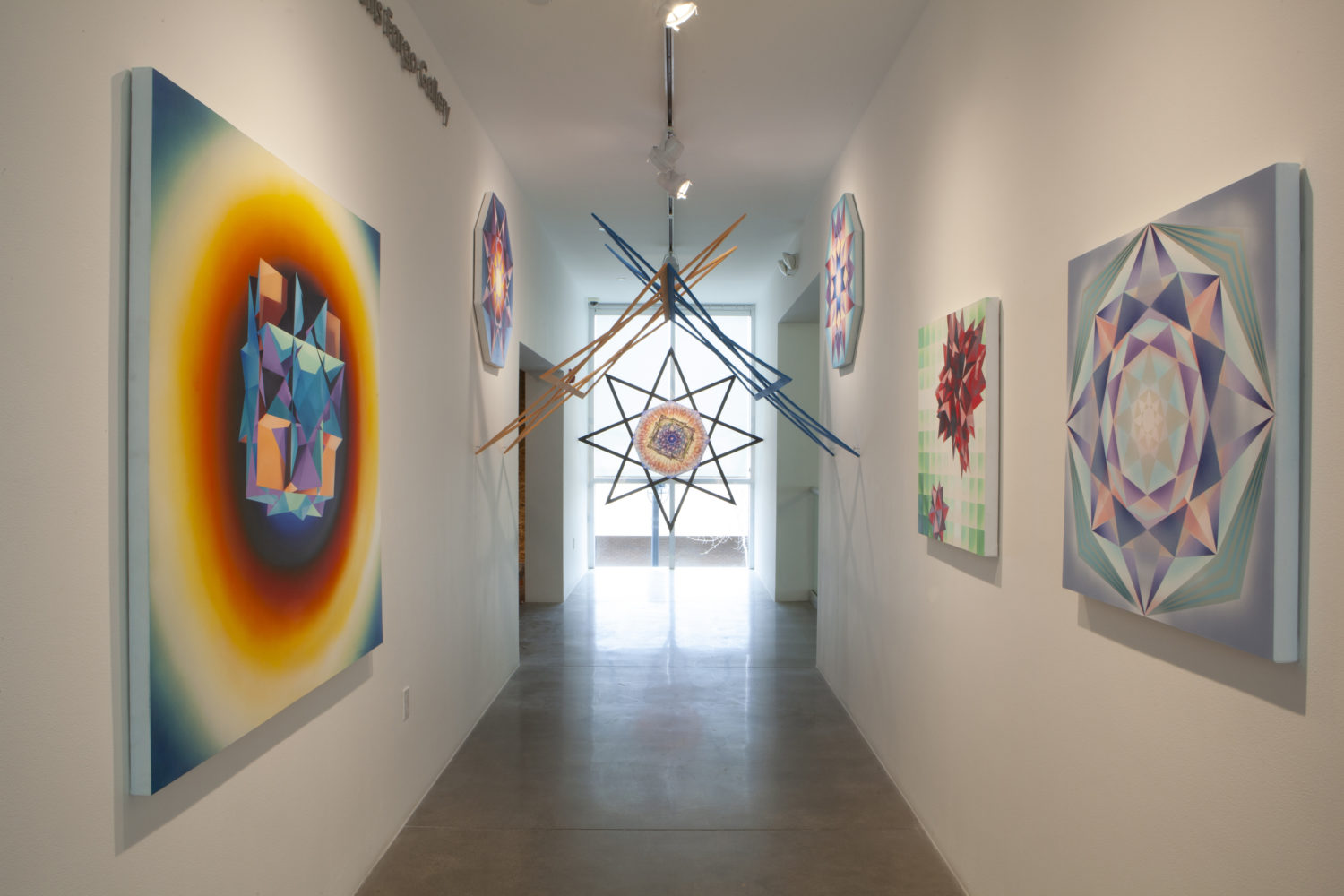
Installation Shot, Iris Oculus, Mary Anna Pomonis Solo Exhibition 2020, Lancaster Museum of Art and History (Photo by Isabel Avila)
What are your latest projects?
2020 has been a crazy year. I started off the year with a solo show, Iris Oculus, at the Lancaster Museum of Art and History. Curators Andi Campognone and Robert Benitez gave me a wonderful opportunity at MOAH and the show lasted one month before it was shut down because of COVID-19. After quarantine, my focus shifted. Because of the virus, I no longer feel a drive to make work only in a singular sense. Instead, I’ve tried really hard to share my creative practice with organizations I care about. I am writing a curriculum right now for the Prison Arts Collective (PAC) and for my class, Art and Social Justice, at Cal State Fullerton, thanks to Annie Buckley, the Executive Director of PAC, and my department chair at CSUF, Jade Jewett.
I am also currently managing the group, the Association of Hysteric Curators (AHC), which has a show coming up in 2021-22 at Dog & Pony this year in Spokane, WA (directed by [the artist] Christopher Russell). The show, My Body, My Truth, is focused on body autonomy and reproductive freedom. In 2020, AHC was able to grant six feminist artists weekly stipends to bridge the gap between work and government unemployment assistance with the help of Seer Gallery. We are a tight group and it has been my honor to work with all of the members of AHC over the years.
Currently I am in a different kind of dream show online, curated by Annie Wharton, director of LADIES’ ROOM LA. Garden is an exhibition of more than 100 women and non-binary artists and artist teams making work during quarantine. The gallery will donate 15% of all sales to benefit the L.A. Food Policy Council, Ron Finley Project, and Summaeverythang Community Center. When Annie conceived of the show, I immediately thought about making a unique abstract piece that dealt with a motif based on tree of life embroidery patterns. The floral tree patterns show up in many ancient cultures and I own a little piece of embroidery from a distant Slovakian cousin, Eleanor Kotlarik Wang (who also happens to be an artist).
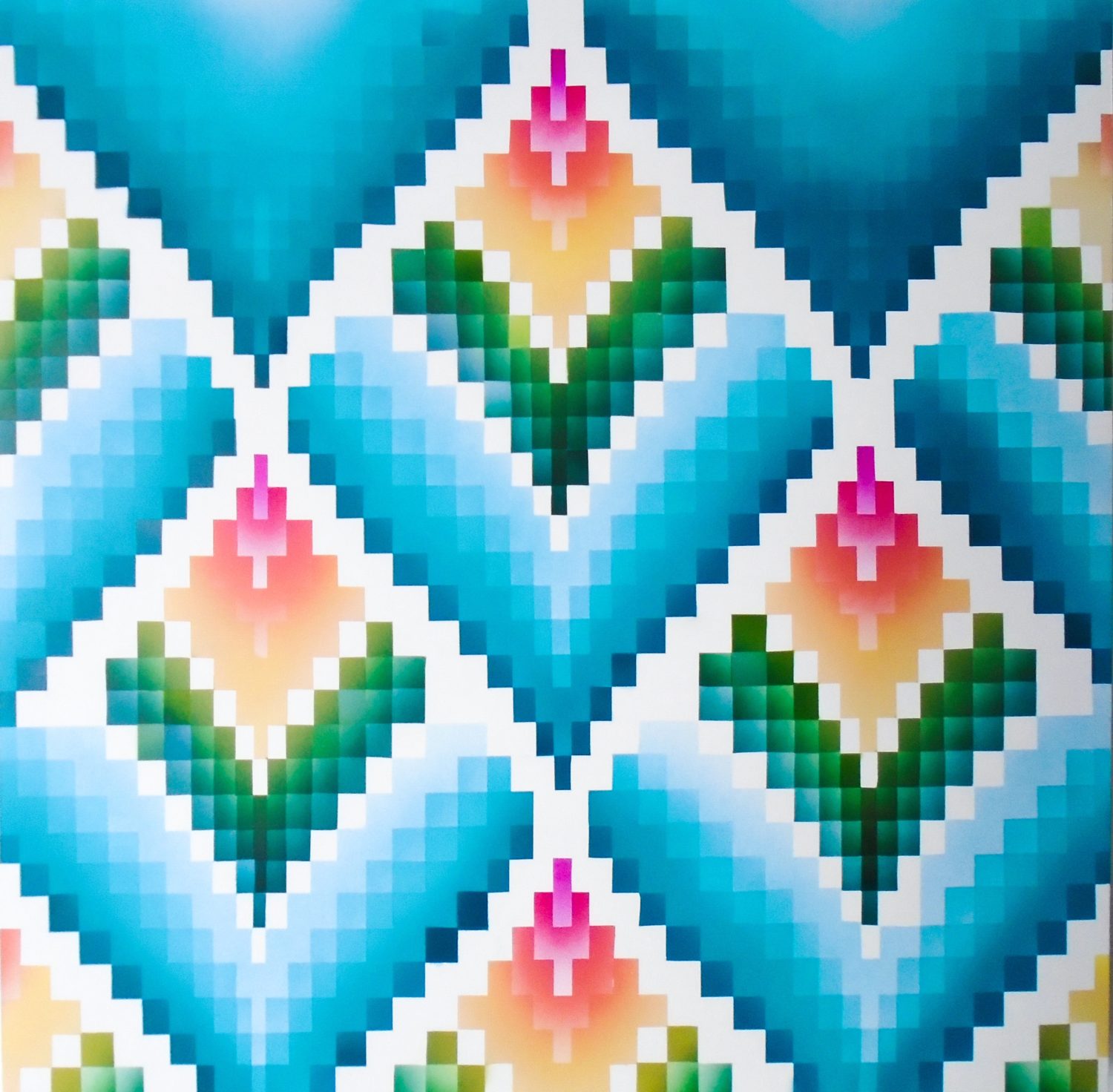
Mary Anna Pomonis, A Flowersnake Cushion For My Lady, 2021 (Courtesy of the Ladies Room Los Angeles)
I decided to make a tree of life garden cushion, something for an imaginary temple priestess to kneel on while tending to the flowers in her garden. The painting, A Flowersnake Cushion For My Lady, is a mash-up of some snakeskin scale studies, embroidery patterns, and of course, the history of feminist abstraction (i.e. the work of Judy Chicago and Miriam Schapiro). I loosely structured the design to resemble both flowers on a trellis and a snake, each an important symbol of the Goddess in her multitude of forms.
The two galleries I am currently working with, LADIES’ ROOM LOS ANGELES and Seer Gallery in Chicago, both show only female-identifying and non-binary artists and focus on representing artists with a feminist ethos. It has been such an honor to work with two feminist art dealers, Annie Wharton and Melissa Klimek! I feel really connected to this amazing feminine energy and love which has saved my mental health during the quarantine.
What music do you listen to in the studio?
This is an impossible question since I listen to music a lot. Lately, I have been listening to the Spinners, the Internet, and Rapsody thanks to my favorite music nerds/artists, Elise McMillen and Josh Stone. I also have to give a shout out to April Bey who turned me on to Sudan Archives. If you haven’t yet watched April’s art studio videos she posts on social media, you are missing out. April really knows how to capture the energy of the music she listens to in her work and she listens to great music. I can’t wait for her upcoming show at the California African American Museum.
Websites and socials please!
Instagram: @maryannapomonis, associationofhystericcurators
Facebook: Association of Hysteric Curators
Twitter: @MAPomonis, @CuratorHysteric
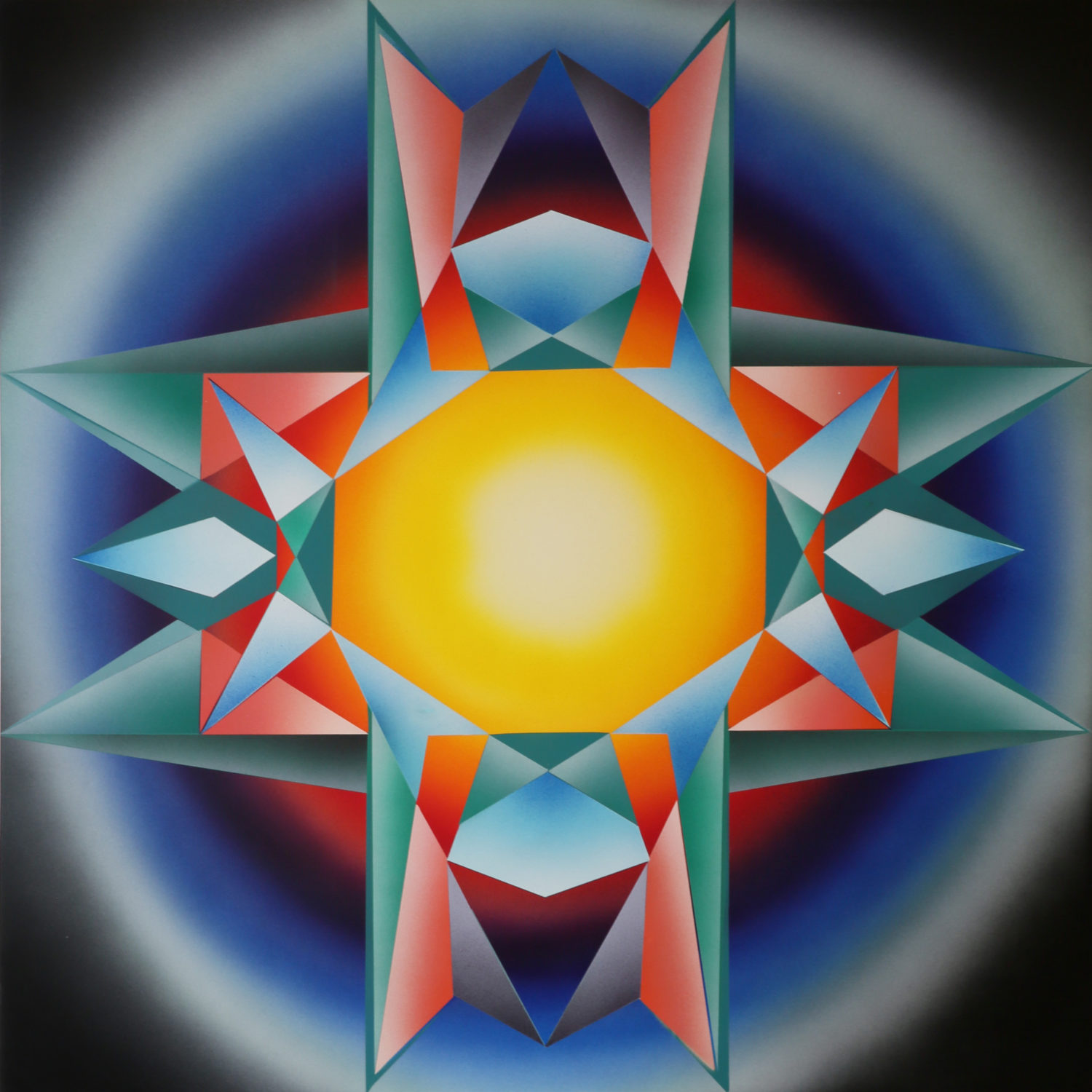
Mary Anna Pomonis, Sailor Venus, 2019, Acrylic Airbrush on Canvas Over Panel, 30x 30 inches (Courtesy of Ladies Room Los Angeles)
Advertising disclosure: We may receive compensation for some of the links in our stories. Thank you for supporting LA Weekly and our advertisers.

